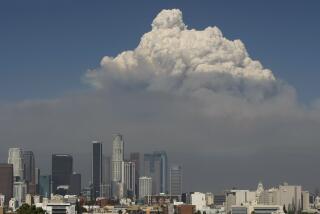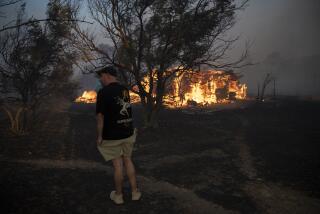VOLCANOES.<i> By Robert Decker and Barbara Decker</i> .<i> W.H. Freeman & Co: 322 pp., $19.95</i> : VOLCANOES: Crucibles of Change.<i> By Richard V. Fisher, Grant Heiken and Jeffrey B. Hulen</i> . <i> Princeton University Press: 320 pp., $35</i>
The 18th-century British ambassador to Naples, Sir William Hamilton, was probably the first volcanologist. Hamilton’s writings on Mt. Vesuvius’ eruptions from 1767 to 1794 are the earliest systematic scientific analysis of volcanic phenomena. But Hamilton saw mainly the destructive side of volcanic behavior and his descriptions and understanding of the geologic processes at work were rudimentary. Today, in the 1990s, we know a great deal more.
The preoccupation with flowing lava has fascinated the public for ages. And for good reason. Pliny the Younger gave us an eyewitness account of the destruction of Pompeii in AD 79, and today, due to the rising world population and the proximity of metropolitan centers such as Seattle and Mexico City to potentially dangerous volcanoes, the danger is no less terrifying and real.
But, as scientists have discovered, volcanoes are nurturers as well as destroyers. The gases they eject helped form and now replenish the Earth’s atmosphere; they may be the atmosphere’s prime original constituent. Volcanoes are also believed to have helped create life in the deep ocean trenches. The bacteria eaten by worms, clams and crabs live on volcanic heat and gases emanating from great vents on the ocean floor.
Volcanoes are prime instruments of plate tectonics, the vast system in which some plates, over long periods of time, dive under others in what is known as subduction zones while, in mid-ocean, the plates are spreading apart and volcanic eruptions are filling the gaps between them creating new crust above the Earth’s mantle.
Without volcanoes, we might not have a living, vibrant planet. Just as during the Age of Exploration when humans began to see the world as round rather than flat, and earlier in this century when the size of the universe in our eyes grew exponentially, our appreciation of what volcanoes do has been deepening dramatically. Just the last 10 years have made a difference.
Measurements of atmospheric dispersions of gas and ash from the Mt. Pinatubo eruption in the Philippines in 1991 verified earlier intimations that major eruptions can lower temperatures worldwide and further deplete the ozone layer. Dives into the ocean depths by research vessels in the last decade have shown the active volcanoes on the mid-ocean ridges. Many exotic deep-sea organisms have been observed near the vents where hot gases and magma are extruded.
“Volcanoes” and “Volcanoes: Crucibles of Change” are penetrating inquiries into everything that is coming to be known about volcanoes. “Crucibles of Change” is more sweeping in its imagination and more entertaining, though sometimes it reaches beyond sure scientific knowledge. Robert and Barbara Decker, on the other hand, are more restrained and more scientifically precise. Both books, however, instruct laymen effectively about volcanic processes, in part by telling the story of some of the best-known eruptions of the recent past, such as Krakatau off the island of Java in 1883 and Mt. St. Helens in Washington in 1980.
Scientists know from excavations of ancient deposits that even the largest eruptions during the last two centuries pale in comparison to some that occurred in prehistoric times. But that does not mean the Earth has grown tamer. It simply reflects that we haven’t been observing long enough to accurately describe a complete range of volcanic possibilities. Even 10,000 years is not a long time for volcanoes, so a span of 200 years provides hardly enough perspective. Eruptions in recent times certainly are spectacular and seem very dramatic. For example, the largest eruption since 1800 was Tambora in the Indonesian archipelago in 1815. It expelled about 40 cubic kilometers of material, according to the Deckers, and its worldwide effects were dramatic. The summer of 1816 in Europe and America never actually warmed up. Snow fell in New England in June. It was known as the “year without a summer.”
But compare this with gargantuan eruptions of long ago, and one can truly appreciate the need for perspective. What would the consequences be on modern life worldwide if there were another eruption such as the one that took place in what is now Yellowstone National Park 2.2 million years ago? That eruption is estimated to have expelled 2,500 cubic kilometers of material, more than 60 times that of Tambora and 1,000 times more than the eruption of Mt. St. Helens. It covered most of what is now the United States west of the Mississippi, including Southern California, with several feet of ash.
Another huge event took place 760,000 years ago in the collapse of the Long Valley caldera surrounding the present town of Mammoth Lakes. That released 600 cubic kilometers of magmatic material and sent ash more than halfway across the continent. As Fisher, Heiken and Hulen observe, “There is an undercurrent of apprehension exhibited by the volcanologists who study the deposits and calderas of truly large eruptions. Judging by problems from the Mt. St. Helens ash fall in eastern Washington, an eruption 1,000 times greater could be a cataclysm beyond imagination.”
But, fortunately, the chance it will occur during our lifetimes is remote. A Tambora occurs about every 1,000 years or roughly every 25 generations. But a Yellowstone is believed to occur only once every 100,000 years or once every 2,500 generations.
Science has moved from gentle theories of evolution, which describe change on Earth as so slow it cannot be observed by a human being, to catastrophism, an appreciation that occasionally the change, such as the extinction of the dinosaurs, may occur almost all at once. Volcanoes are potentially great catastrophes, as are collisions of asteroids with the Earth. But the odds are extremely high that such things on their largest scale will not happen soon in human time. If there is one such eruption every 100,000 years or every several hundred thousand years, it is obviously not at all likely to strike the next human generation.
Still, these books take a long look, and sometimes, even if the consequences are not worldwide, the results are shocking. For instance, the Mt. St. Helens avalanche, triggered by an earthquake (in the magnitude 5 range) that occurred seconds before the actual eruption, lowered the mountain by 1,300 feet and completely devastated an area ranging 19 miles north and west from the site of the blast. Fifty-seven people were killed. That got scientists to looking. They then recognized that the hillocks that mark the terrain north and west of Mt. Shasta in Northern California resulted from a similar avalanche there. They now estimate that such an avalanche is conceivable at Mt. Rainier and many other volcanoes.
Gigantic volcanically induced slides under the sea are also evident. Fisher, Heiken and Hulen note that off the northeastern shore of Oahu in the Hawaiian chain, there is a gigantic landslide of rocks extending for 242 kilometers. Such slides, while highly unlikely in any given millennium, have occurred in Hawaii many times. One in modern times would be absolutely devastating, and not only in the state of Hawaii, but also across the Pacific by triggering tsunamis.
When Mt. Pelee on the island of Martinique loosed a gaseous pyroclastic cloud on the morning of May 8, 1902, it killed 29,933 residents of the city of St. Pierre, four miles away, just two minutes later. Until then, most scientists did not appreciate that such a thing could occur at a volcano, even though the Vesuvius eruption that destroyed Pompei was related to it. Now, it is appreciated that pyroclastic flows, which are superheated combinations of rocks, ash and gas that move at 100 mph or more, are much more dangerous than lava. “Crucibles of Change” contains fascinating charts on volcanic casualties since 1600. During that time, pyroclastic flows killed about 55,000 people worldwide. Lava flows, which are much slower moving, killed only about 1,000.
It used to be that starvation and disease were a leading result of catastrophic eruptions. More than 92,000 died from these causes between 1600 and 1899, but only 3,200 since 1900. Modern means of distributing food have contributed to that improvement. Other major causes of death from volcanoes in the last four centuries include 36,700 from mud or debris flows, 44,000 from tsunamis (including 36,000 from the Krakatau eruption alone) and 11,000 from ash falls, collapsing buildings and ballistic projectiles.
And yet, as these authors note, volcanoes can be good, even essential, for a healthy planet. Not only in creating atmosphere or new crust, but in such utilitarian ways as facilitating geothermal development of cheap energy from the internal heat of the Earth, and the slow funneling of precious stones, such as diamonds, to the surface. “In fact,” the Deckers remark, “diamonds might not be all that rare if we could mine them at their deep source. Their occurrence at the Earth’s surface results from a rare type of volcano eruption that transports them rapidly from great depths.”
It is such reporting of widely unknown volcanic phenomena that makes these books compelling to those who would learn more about the workings of the planet. These books are popular primers. They demonstrate that we must be wary and mindful of volcanic dangers around us and accepting of volcanoes as an integral part of life itself.






